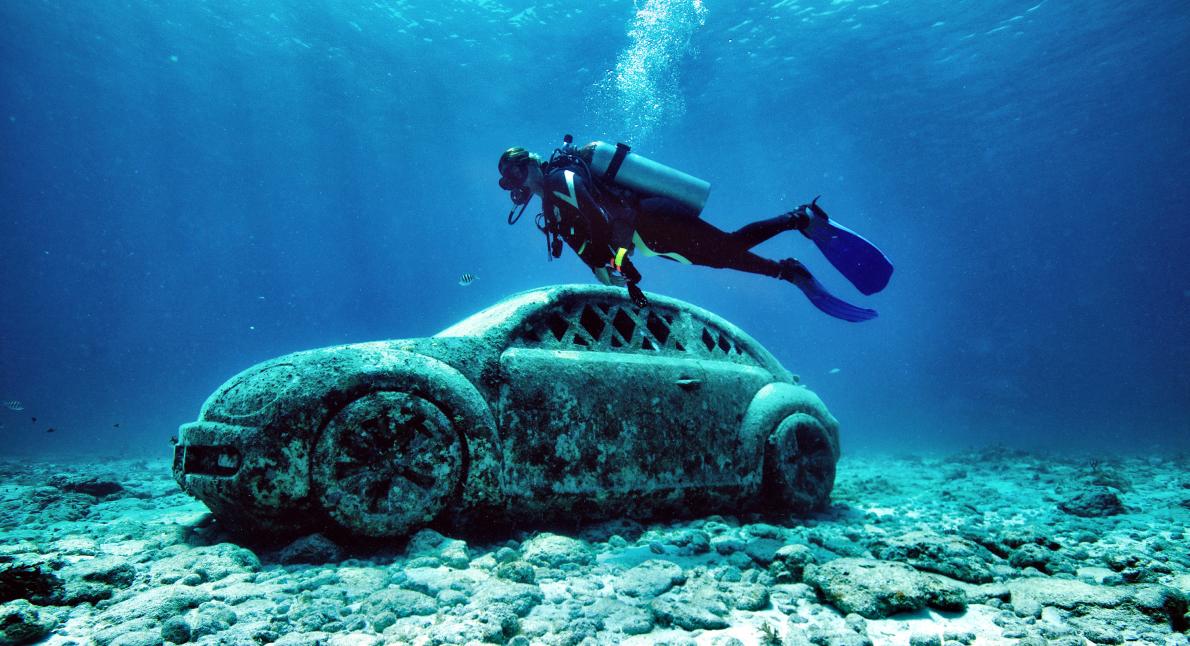OMG! weirdest museums is #5
5 of the World’s Weirdest Museums
These treasure troves around the globe will satisfy your strangest curiosities.

A diver drifts over a submerged vehicle at MUSA, the underwater museum of contemporary art in Cancun, Mexico.
What turns an ordinary object into something extraordinary? Put it in a museum. No matter how seemingly odd or mundane, objects offer us windows into history and connect us to our past. They expose our darkest preoccupations, most brilliant ideas, and the limitless creativity of the human mind.

Gunther Von Hagens’s plastination institute displays preserved bodies in creative positions—like this archer—to showcase the intricacies of the human form.
After 39 years studying medicine, dissection, and chemistry, Gunther von Hagens perfected plastination—a controversial process in which polymers are used to preserve human tissue. Visitors who tour the PLASTINARIUM receive a history lesson in anatomy, witness the graphic process of plastination, and can view a showroom of humans and animals in creative poses. The center also supplies traveling Body Worlds exhibits, which have been the subject of various ethical debates on body procurement and the handling of human remains post-mortem.
MUSEUM OF SEX

The Museum of Sex opened in 2002 with the intent of preserving the history, evolution, and cultural significance of human sexuality. New York Magazine described a visit to this museum akin to “a Willy Wonka sex dream,” where you can treat your inner kid-adult to a round in the outlandish Bouncy Castle of Breasts or admire vintage erotic photography. The museum hosts temporary exhibitions as well as a permanent collection of over 15,000 artifacts, works of art, photography, costumes, and historical memorabilia—all with the intent of creating an open discourse around sex and sexuality
THE MUMMY MUSEUM

A mummified child sits on display at the Mummy Museum in Guanajuato, one of Mexico’s most popular tourist attractions.
In the small mining town of Guanajuato—a UNESCO World Heritage site—hundreds of bodies were buried in the Santa Paula Pantheon’s crypts during the mid-19th century. If families were unable to pay a burial tax imposed by the town, the bodies were exhumed. It was then that they discovered the bodies had been mummified through a natural process, likely due to the region’s unique climactic factors. Their ghoulish corpses—including those of infants—are now on display at the Museo de Las Momias, or Mummy Museum.
CANCUN UNDERWATER MUSEUM

Cancun's underwater museum is a collaboration between biologists and artist Jason deCaires Taylor, who created an “urban reef” that fosters diverse marine life.
Constructed in 2009 in the azure waters surrounding Cancun, Isla Mujeres, and Punta Nizuc, Museo Subacuático de Arte (MUSA) features over 500 life-size sculptures fixed to the sea floor. The oceanic art doubles as an artificial reef specially designed to promote the growth of coral, which continually transforms the aquatic landscape. The result is an eerily beautiful visual representation of humans’ interaction with the environment. Visitors can explore the museum by glass bottom boat, snorkeling, or scuba diving.